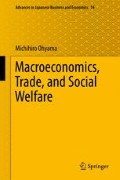Abstract
The fundamental theorems of welfare economics prove under stringent conditions that the free market mechanism leads to the efficient allocation of economic resources. It is highly regarded as a theoretical underpinning of the “invisible hand” (Adam Smith), but generally inapplicable to the real economies in modern societies where externalities abound that cannot be addressed by the market mechanism. First, social needs for public goods are increasing in the face of rapid industrialization and urbanization. They call for construction and maintenance of stronger industrial infrastructure and further improvement of environmental and educational facilities. Second, governments are often required to employ taxes and subsidies to alleviate pollution, congestion, and depletion of natural resources stemming from Marshallian externalities interacted among a large number of citizens. The purpose of this chapter is to provide a comprehensive theoretical framework for mixed economies facing the problems of externalities and public goods.
Access this chapter
Tax calculation will be finalised at checkout
Purchases are for personal use only
References
Knight, F. H. (1924). Some fallacies in the interpretation of social cost. The Quarterly Journal of Economics, 38, 582–606.
Lindahl, E. (1967). Just taxation: a positive solution. In R. A. Musgrave & A. T. Peacock (Eds.), Classics in the theory of public finance (pp. 168–187). London: Macmillan.
Marshall, A. (1890) Principles of economics (8th ed., 1920). London: Macmillan.
Mas-Collel, A., Whinston, M. D., & Green, J. R. (1995). Microeconomic theory. Oxford: Oxford University Press.
Mohring, H., & Boyed, J. H. (1971). Analyzing “externalities,” “direct interaction” vs. “asset utilization” frameworks. Economica, 38, 347–361.
Mohring, H., & Harwitz, M. (1962). Highway benefits: An analytical framework. Evanston: North Western University Press.
Oakland, W. H. (1969). Joint goods. Economica, 36, 253–268.
Oakland, W. H. (1972). Congestion, public goods and welfare. Journal of Public Economics, 1, 339–357.
Pigou, A.C. (1920). The economics of welfare (4th ed., 1932). London: Macmillan.
Samuelson, P. A. (1954). The pure theory of public expenditure. Review of Economics and Statistics, 36, 387–389.
Samuelson, P. A. (1956). Social indifference curves. The Quarterly Journal of Economics, 70, 1–22.
Samuelson, P. A. (1969). The pure theory of public expenditure and taxation. In J. Margolis & H. Guitton (Eds.), Public economics (pp. 98–123). New York: St. Martin’s Press.
Sandmo, A. (1973). Public goods and the technology of consumption. The Review of Economic Studies, 40, 517–528.
Steiner, P. O. (1957). Peak loads and efficient pricing. The Quarterly Journal of Economics, 71(4), 585–610.
Strotz, R. H. (1965). Urban transportation parables. In J. Margolis (Ed.), The public economy of urban communities (pp. 127–169). Washington, DC: Resources for the Future.
Uzawa, H. (1974). Sur la theorie du capital cllecvtif social. Cahier du Econometrie et economique.
Weisbrod, B. A. (1964). Collective consumption services of individual consumption goods. The Quarterly Journal of Economics, 78, 471–477.
Williamson, O. E. (1966). Peak load pricing and optimal capacity. The American Economic Review, 56, 810–827.
Zeckhauser, R. J. (1969). Resource allocation with probabilistic individual preferences. The American Economic Review, 59, 546–552.
Author information
Authors and Affiliations
Rights and permissions
Copyright information
© 2016 Springer Japan
About this chapter
Cite this chapter
Ohyama, M. (2016). A Theoretical Framework of Mixed Systems. In: Macroeconomics, Trade, and Social Welfare. Advances in Japanese Business and Economics, vol 14. Springer, Tokyo. https://doi.org/10.1007/978-4-431-55807-1_12
Download citation
DOI: https://doi.org/10.1007/978-4-431-55807-1_12
Published:
Publisher Name: Springer, Tokyo
Print ISBN: 978-4-431-55805-7
Online ISBN: 978-4-431-55807-1
eBook Packages: Economics and FinanceEconomics and Finance (R0)

